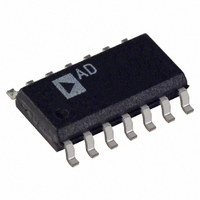SSM2166S Analog Devices Inc, SSM2166S Datasheet - Page 11

SSM2166S
Manufacturer Part Number
SSM2166S
Description
IC PREAMP AUDIO MONO MIC 14SOIC
Manufacturer
Analog Devices Inc
Datasheet
1.SSM2166SZ-REEL7.pdf
(20 pages)
Specifications of SSM2166S
Rohs Status
RoHS non-compliant
Output Type
1-Channel (Mono)
Voltage - Supply
4.5 V ~ 5.5 V
Features
Microphone
Mounting Type
Surface Mount
Package / Case
14-SOIC (3.9mm Width), 14-SOL
Max Output Power X Channels @ Load
-
Available stocks
Company
Part Number
Manufacturer
Quantity
Price
Part Number:
SSM2166SZ
Manufacturer:
ADI/亚德诺
Quantity:
20 000
Because limiting occurs for signals larger than the rotation point
(V
signal level. It is recommended that the rotation point be set at
the upper extreme of the range of typical input signals so that
the compression region covers the entire desired input signal
range. Occasional larger signal transients are then attenuated by
the action of the limiter.
VCA Gain Setting and Muting
The maximum gain of the SSM2166 is set by the GAIN ADJUST
pin (Pin 2) via R
20 kΩ, causes the nominal VCA gain to vary from 0 dB to
approximately 20 dB, respectively. Setting the VCA gain to its
maximum can also be achieved by leaving the GAIN ADJUST
pin in an open condition (no connect). Figure 22 illustrates the
effect on the transfer characteristic by varying this parameter.
For low level signal sources, the VCA should be set to maximum
gain using a 20 kΩ resistor.
IN
> V
RP
), the rotation point effectively sets the maximum output
Figure 22. Effect of Varying the VCA Gain Setting
Figure 21. Effect of Varying the Rotation Point
V
DE
GAIN
V
DE
. This resistor, with a range of 1 kΩ to
r:1
1
r:1
1
INPUT (dB)
INPUT (dB)
1
1
GAIN
VCA
V
RP1
GAIN
VCA
V
RP2
V
RP
GAIN
VCA
V
VCA GAIN
RP3
Rev. D | Page 11 of 20
The gain of the VCA can be reduced below 0 dB by making
R
to GND mutes the output. Either a switch connected to ground or a
transistor can be used, as shown in Figure 23. To avoid audible
clicks when using the mute feature, a capacitor (C5) can be
connected from Pin 2 to GND. The value of the capacitor is
arbitrary and should be determined empirically, but a 0.01 μF
capacitor is a good starting value.
Downward Expansion Threshold
The downward expansion threshold, or noise gate, is deter-
mined via a second reference voltage internal to the control
circuitry. This second reference can be varied in the SSM2166
using a resistor, R
and the NOISE GATE SET pin (Pin 9). The effect of varying this
threshold is shown in Figure 24. The downward expansion
threshold can be set between 300 μV rms and 20 mV rms by
varying the resistance value between Pin 9 and the supply
voltage. Like the ROTATION SET pin, the downward expansion
threshold is inversely proportional to the value of this resistance:
setting this resistance to 1 MΩ sets the threshold at approximately
250 μV rms, whereas a 10 kΩ resistance sets the threshold at
approximately 20 mV rms. This relationship is illustrated in
Figure 5. A potentiometer network is provided on the evaluation
board for this adjustment. In general, the downward expansion
threshold should be set at the lower extreme of the desired range of
the input signals so that signals below this level are attenuated.
Figure 24. Effect of Varying the Downward Expansion (Noise Gate) Threshold
GAIN
smaller than 1 kΩ. Switching Pin 2 through 330 Ω or less
NOTES
1. ADDITIONAL CIRCUIT DETAILS OMITTED
V
FOR CLARITY.
DE1
C5
V
DE2
GATE
Figure 23. Details of Mute Option
V
R
DE3
GAIN
, connected between the positive supply
2
SSM2166
GAIN ADJUST
r:1
1
INPUT (dB)
1
330Ω
MUTE
(CLOSED SWITCH)
V
RP
VCA GAIN
SSM2166













